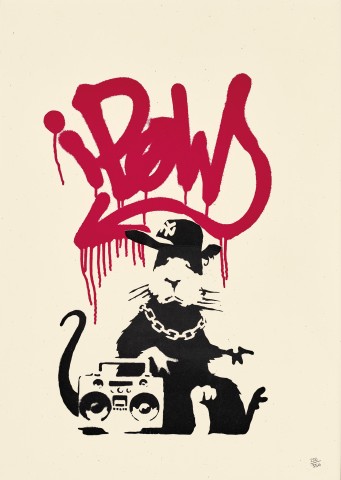GANGSTA RAT, 2004
BANKSY
colour screenprint
49.0 x 53.0 cm (sheet)
published by Pictures on Walls, London
numbered and embossed with blindstamp lower right
Private collection, Queensland, acquired in Brighton, U.K., c.2005
Personified rats have been an enduring motif in street artist Banksy’s oeuvre, often depicted in slapstick freeze frames and comically dressed to reflect salient contemporary issues in Britain and abroad. Understood by many to be a homage to Blek le Rat, Xavier Prou, the French pioneer of stencil art, Banksy’s rodent alter-egos exist on the fringes of society. Living invisibly in alleyways and undergrounds, much like clandestine graffiti artists, for Banksy these animals have come to symbolise freedom and resilience. Like many of his artworks, the Gangsta Rat, 2004 of this limited-edition screenprint first appeared stenciled directly onto a wall, in the London suburb of Farringdon in 2004. Shortly thereafter, with the artist-run publishing cooperative Pictures on Walls, Bansky printed Gangsta Rat in black and red in an edition of 350, with an additional 150 prints hand-signed. Circumventing commercial gallery structures, examples of these prints were sold directly to buyers through the internet and pop-up exhibitions. While Banksy created over 30 different street artworks using rats in the 1990s,1 Gangsta Rat was the first design to be screenprinted, preceding the other ‘Rat Pack’ editions such as Love Rat, Placard Rats – holding signs emblazoned with ‘Because I’m Worthless’, ‘Welcome to Hell’ and ‘Get out while you can’ and Radar Rat.
With hands held aloft and a look of surprise etched into its white face, Gangsta Rat appears to have been caught playing dress-up. Wearing a side-ways New York Yankees baseball cap, an earring and chain medallion necklace, the rat sits beside a Boom Box portable stereo system, imitating the flashy style of American hip hop and rap artists of the 1980s. Tagged in dripping red spray paint above the rat are the letters iPOW, referencing Bansky’s print publisher Pictures on Walls and imitating the nonsensical marketing jargon of large corporations in the early 2000s. Banksy’s trussed-up rat derides both the opportunistic bastardisation of popular culture to sell products, and the mindless rat-race of consumer culture.
Banksy, who like a latter-day Robin Hood remains officially anonymous, became a household name around the world with a reach far beyond the Bristol underground scene from which he emerged in the early 1990s. In 2018, he memorably made headlines after one of his works appeared to self-destruct just after selling at auction in London for over a million pounds, thus playfully reinforcing the artist’s apparent disdain for the commercial structures of the art world. The elusive artist’s work, whether stenciled on a nondescript brick wall of a housing estate or screen-printed on archival paper, is instantly recognisable for its cutting social satire, whimsical popular culture references and subversive aphorisms.
1. Banksy, Wall and Piece, Century, London, 2005, pp. 86 – 87
LUCIE REEVES-SMITH
